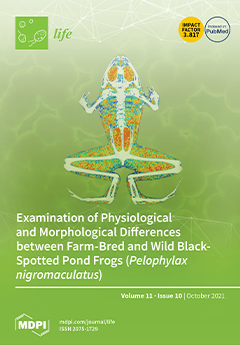The fish parasite,
Neoergasilus japonicus (Harada, 1930), native to Eastern Siberia and the Amur River catchment area, invaded European water bodies in the middle of the last century, possibly due to the human-mediated distribution of fish in the Amur complex (i.e., the genera
[...] Read more.
The fish parasite,
Neoergasilus japonicus (Harada, 1930), native to Eastern Siberia and the Amur River catchment area, invaded European water bodies in the middle of the last century, possibly due to the human-mediated distribution of fish in the Amur complex (i.e., the genera
Hypophthalmichthys and
Ctenopharyngodon). In the deep karst lake, Grand Laoucien (Marseille area, France), this species had an unusually high population density (from 1000 ind./ m
3 in zooplankton to 4000 ind./ m
3 in the nearshore area) during the free-living period of its life cycle. The annual cycle of
N. japonicus includes a 5-month overwintering of fertilized females attached to fish fins and, following this, a five- to six-generation chain from March to November, when the free-living stages in the population alternate with parasite females which attach to their hosts for breeding. The population density of the parasites in zooplankton increased exponentially from spring to autumn, which positively correlated with temperature. We found a strong correlation between
N. japonicus density and the community development of microphytobenthos, but not between
N. japonicus and phyto- or zooplankton dynamics. The local contributing factors included a seasonal three-fold decrease in water levels and the development of anoxia in profundal waters, which led to a high ambient fish density and thus susceptibility to the parasite. Although the free-living parasite represented only 1% of zooplankton production, it consumed up to 25% of small invertebrate productivity. The maximum intensity of infection reached 140 parasites per fish, or 4.14 per g of weight. The high infection of fish with this parasite, in our opinion, indicated the danger it poses to the local ichthyofauna, which first encountered this new parasite.
Full article






